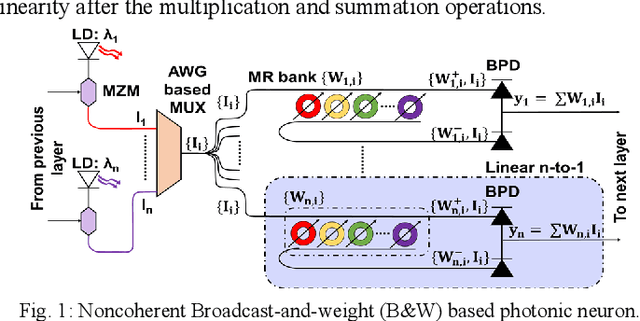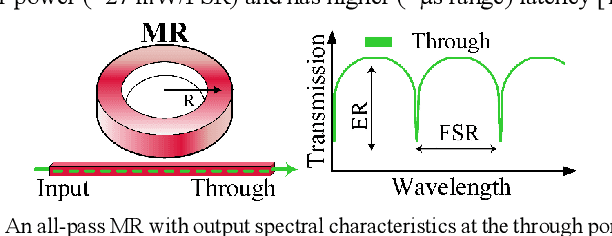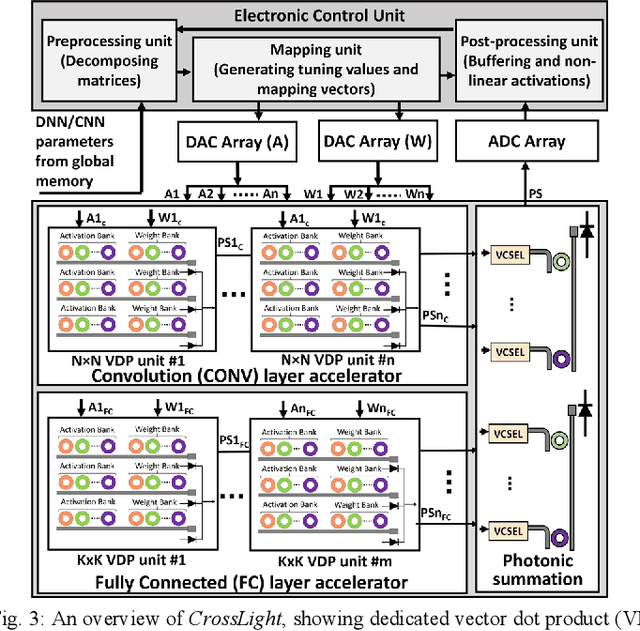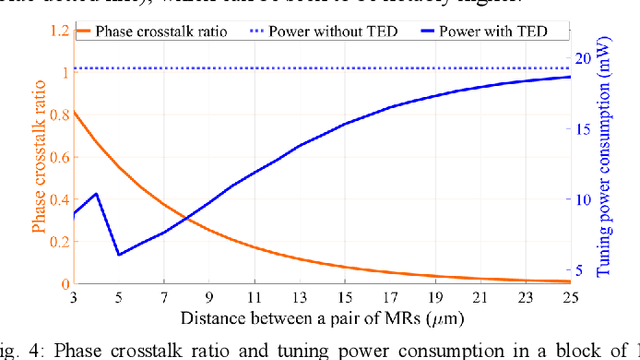Febin Sunny
OPIMA: Optical Processing-In-Memory for Convolutional Neural Network Acceleration
Jul 11, 2024Abstract:Recent advances in machine learning (ML) have spotlighted the pressing need for computing architectures that bridge the gap between memory bandwidth and processing power. The advent of deep neural networks has pushed traditional Von Neumann architectures to their limits due to the high latency and energy consumption costs associated with data movement between the processor and memory for these workloads. One of the solutions to overcome this bottleneck is to perform computation within the main memory through processing-in-memory (PIM), thereby limiting data movement and the costs associated with it. However, DRAM-based PIM struggles to achieve high throughput and energy efficiency due to internal data movement bottlenecks and the need for frequent refresh operations. In this work, we introduce OPIMA, a PIM-based ML accelerator, architected within an optical main memory. OPIMA has been designed to leverage the inherent massive parallelism within main memory while performing high-speed, low-energy optical computation to accelerate ML models based on convolutional neural networks. We present a comprehensive analysis of OPIMA to guide design choices and operational mechanisms. Additionally, we evaluate the performance and energy consumption of OPIMA, comparing it with conventional electronic computing systems and emerging photonic PIM architectures. The experimental results show that OPIMA can achieve 2.98x higher throughput and 137x better energy efficiency than the best-known prior work.
Silicon Photonic 2.5D Interposer Networks for Overcoming Communication Bottlenecks in Scale-out Machine Learning Hardware Accelerators
Mar 07, 2024Abstract:Modern machine learning (ML) applications are becoming increasingly complex and monolithic (single chip) accelerator architectures cannot keep up with their energy efficiency and throughput demands. Even though modern digital electronic accelerators are gradually adopting 2.5D architectures with multiple smaller chiplets to improve scalability, they face fundamental limitations due to a reliance on slow metallic interconnects. This paper outlines how optical communication and computation can be leveraged in 2.5D platforms to realize energy-efficient and high throughput 2.5D ML accelerator architectures.
Accelerating Neural Networks for Large Language Models and Graph Processing with Silicon Photonics
Jan 12, 2024



Abstract:In the rapidly evolving landscape of artificial intelligence, large language models (LLMs) and graph processing have emerged as transformative technologies for natural language processing (NLP), computer vision, and graph-structured data applications. However, the complex structures of these models pose challenges for acceleration on conventional electronic platforms. In this paper, we describe novel hardware accelerators based on silicon photonics to accelerate transformer neural networks that are used in LLMs and graph neural networks for graph data processing. Our analysis demonstrates that both hardware accelerators achieve at least 10.2x throughput improvement and 3.8x better energy efficiency over multiple state-of-the-art electronic hardware accelerators designed for LLMs and graph processing.
GHOST: A Graph Neural Network Accelerator using Silicon Photonics
Jul 04, 2023



Abstract:Graph neural networks (GNNs) have emerged as a powerful approach for modelling and learning from graph-structured data. Multiple fields have since benefitted enormously from the capabilities of GNNs, such as recommendation systems, social network analysis, drug discovery, and robotics. However, accelerating and efficiently processing GNNs require a unique approach that goes beyond conventional artificial neural network accelerators, due to the substantial computational and memory requirements of GNNs. The slowdown of scaling in CMOS platforms also motivates a search for alternative implementation substrates. In this paper, we present GHOST, the first silicon-photonic hardware accelerator for GNNs. GHOST efficiently alleviates the costs associated with both vertex-centric and edge-centric operations. It implements separately the three main stages involved in running GNNs in the optical domain, allowing it to be used for the inference of various widely used GNN models and architectures, such as graph convolution networks and graph attention networks. Our simulation studies indicate that GHOST exhibits at least 10.2x better throughput and 3.8x better energy efficiency when compared to GPU, TPU, CPU and multiple state-of-the-art GNN hardware accelerators.
TRON: Transformer Neural Network Acceleration with Non-Coherent Silicon Photonics
Mar 22, 2023Abstract:Transformer neural networks are rapidly being integrated into state-of-the-art solutions for natural language processing (NLP) and computer vision. However, the complex structure of these models creates challenges for accelerating their execution on conventional electronic platforms. We propose the first silicon photonic hardware neural network accelerator called TRON for transformer-based models such as BERT, and Vision Transformers. Our analysis demonstrates that TRON exhibits at least 14x better throughput and 8x better energy efficiency, in comparison to state-of-the-art transformer accelerators.
Cross-Layer Design for AI Acceleration with Non-Coherent Optical Computing
Mar 22, 2023



Abstract:Emerging AI applications such as ChatGPT, graph convolutional networks, and other deep neural networks require massive computational resources for training and inference. Contemporary computing platforms such as CPUs, GPUs, and TPUs are struggling to keep up with the demands of these AI applications. Non-coherent optical computing represents a promising approach for light-speed acceleration of AI workloads. In this paper, we show how cross-layer design can overcome challenges in non-coherent optical computing platforms. We describe approaches for optical device engineering, tuning circuit enhancements, and architectural innovations to adapt optical computing to a variety of AI workloads. We also discuss techniques for hardware/software co-design that can intelligently map and adapt AI software to improve its performance on non-coherent optical computing platforms.
Machine Learning Accelerators in 2.5D Chiplet Platforms with Silicon Photonics
Jan 28, 2023Abstract:Domain-specific machine learning (ML) accelerators such as Google's TPU and Apple's Neural Engine now dominate CPUs and GPUs for energy-efficient ML processing. However, the evolution of electronic accelerators is facing fundamental limits due to the limited computation density of monolithic processing chips and the reliance on slow metallic interconnects. In this paper, we present a vision of how optical computation and communication can be integrated into 2.5D chiplet platforms to drive an entirely new class of sustainable and scalable ML hardware accelerators. We describe how cross-layer design and fabrication of optical devices, circuits, and architectures, and hardware/software codesign can help design efficient photonics-based 2.5D chiplet platforms to accelerate emerging ML workloads.
A Silicon Photonic Accelerator for Convolutional Neural Networks with Heterogeneous Quantization
May 17, 2022



Abstract:Parameter quantization in convolutional neural networks (CNNs) can help generate efficient models with lower memory footprint and computational complexity. But, homogeneous quantization can result in significant degradation of CNN model accuracy. In contrast, heterogeneous quantization represents a promising approach to realize compact, quantized models with higher inference accuracies. In this paper, we propose HQNNA, a CNN accelerator based on non-coherent silicon photonics that can accelerate both homogeneously quantized and heterogeneously quantized CNN models. Our analyses show that HQNNA achieves up to 73.8x better energy-per-bit and 159.5x better throughput-energy efficiency than state-of-the-art photonic CNN accelerators.
SONIC: A Sparse Neural Network Inference Accelerator with Silicon Photonics for Energy-Efficient Deep Learning
Sep 09, 2021



Abstract:Sparse neural networks can greatly facilitate the deployment of neural networks on resource-constrained platforms as they offer compact model sizes while retaining inference accuracy. Because of the sparsity in parameter matrices, sparse neural networks can, in principle, be exploited in accelerator architectures for improved energy-efficiency and latency. However, to realize these improvements in practice, there is a need to explore sparsity-aware hardware-software co-design. In this paper, we propose a novel silicon photonics-based sparse neural network inference accelerator called SONIC. Our experimental analysis shows that SONIC can achieve up to 5.8x better performance-per-watt and 8.4x lower energy-per-bit than state-of-the-art sparse electronic neural network accelerators; and up to 13.8x better performance-per-watt and 27.6x lower energy-per-bit than the best known photonic neural network accelerators.
CrossLight: A Cross-Layer Optimized Silicon Photonic Neural Network Accelerator
Feb 13, 2021



Abstract:Domain-specific neural network accelerators have seen growing interest in recent years due to their improved energy efficiency and inference performance compared to CPUs and GPUs. In this paper, we propose a novel cross-layer optimized neural network accelerator called CrossLight that leverages silicon photonics. CrossLight includes device-level engineering for resilience to process variations and thermal crosstalk, circuit-level tuning enhancements for inference latency reduction, and architecture-level optimization to enable higher resolution, better energy-efficiency, and improved throughput. On average, CrossLight offers 9.5x lower energy-per-bit and 15.9x higher performance-per-watt at 16-bit resolution than state-of-the-art photonic deep learning accelerators.
 Add to Chrome
Add to Chrome Add to Firefox
Add to Firefox Add to Edge
Add to Edge